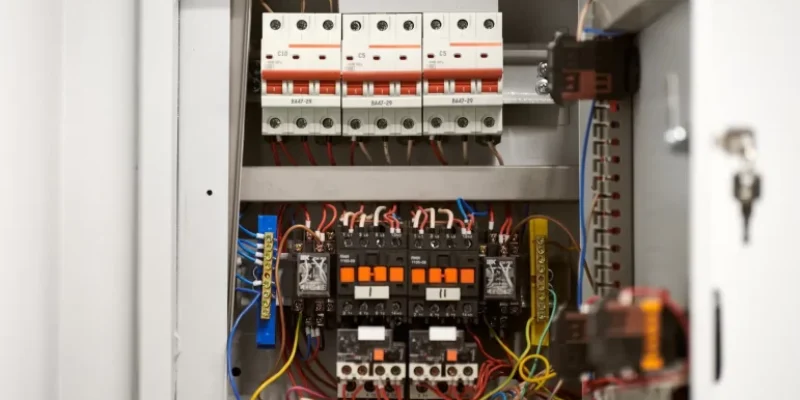Introducción
En los sistemas eléctricos modernos, elegir entre una caja de distribución de CA (corriente alterna) y una caja de distribución de CC (corriente continua) es fundamental para optimizar el rendimiento y garantizar la seguridad. Cada tipo cumple funciones únicas en función de la aplicación, por lo que es esencial conocer sus diferencias y su idoneidad para los distintos sistemas eléctricos.
¿Qué es una caja de distribución de CA?
Un AC caja de distribución está diseñado para gestionar y distribuir energía eléctrica de corriente alterna. Su función principal es facilitar la distribución segura de la electricidad desde el suministro principal a varios circuitos dentro de un edificio o instalación. Los componentes típicos de una caja de distribución de corriente alterna incluyen:
- Interruptores automáticos: Protección contra sobrecargas y cortocircuitos.
- Interruptores: Proporcionan control manual sobre los circuitos eléctricos.
- Fusibles: Ofrecen protección adicional contra situaciones de sobrecorriente.
Estas cajas se utilizan habitualmente en entornos residenciales, comerciales e industriales para garantizar una gestión eficiente de la energía.
¿Qué es una caja de distribución de CC?
En cambio, una caja de distribución de CC está diseñada para gestionar la energía eléctrica de corriente continua. Consolida la corriente continua procedente de fuentes como paneles solares o baterías antes de distribuirla a las distintas cargas. Los componentes clave que suelen encontrarse en una caja de distribución de CC son:
- Los fusibles: Protegen contra las condiciones de sobreintensidad específicas de los sistemas de CC.
- Convertidores: Facilitan la conversión de los niveles de tensión continua cuando es necesario.
- Protectores contra sobretensiones: Protegen contra los picos de tensión.
Las cajas de distribución de corriente continua son esenciales en aplicaciones relacionadas con sistemas de energías renovables, telecomunicaciones y vehículos eléctricos.
Principales diferencias entre las cajas de distribución de CA y CC
Características eléctricas
- Alimentación CA: Alterna la dirección periódicamente, lo que permite transformar la tensión con mayor facilidad.
- Corriente continua: Fluye en una dirección, proporcionando un nivel de tensión constante.
Diseño y componentes
- Cajas de distribución de CA: Suelen incluir disyuntores para protección contra sobrecargas y pueden alojar transformadores para ajustes de tensión.
- Cajas de distribución de CC: Utilice fusibles adaptados para aplicaciones de CC y haga hincapié en mantener niveles de tensión estables.
Aplicaciones
- Cajas de distribución de CA: Ampliamente utilizadas en entornos residenciales, industriales y comerciales.
- Cajas de distribución de CC: Se encuentran principalmente en sistemas de energías renovables, infraestructuras de telecomunicaciones y estaciones de carga de vehículos eléctricos.
Aplicaciones de las cajas de distribución de CA
Uso residencial
Las cajas de distribución de CA gestionan eficazmente los sistemas eléctricos domésticos, garantizando una distribución de energía segura y fiable a diversos aparatos y circuitos.
Uso industrial
En entornos industriales, las cajas de distribución de CA distribuyen energía a grandes máquinas y equipos pesados, facilitando un funcionamiento fluido e ininterrumpido.
Uso comercial
Los entornos comerciales, como los edificios de oficinas y los espacios comerciales, confían en las cajas de distribución de CA para obtener soluciones eficaces de gestión de la energía.
Aplicaciones de las cajas de distribución de CC
Sistemas de energía renovable
Las cajas de distribución de corriente continua son fundamentales en las instalaciones de energía solar y eólica, ya que gestionan la energía generada y garantizan una distribución eficaz a los distintos sistemas.
Telecomunicaciones
Las redes de telecomunicaciones dependen de las cajas de distribución de corriente continua para suministrar energía fiable a los equipos críticos, apoyando los servicios de comunicación ininterrumpida.
Vehículos eléctricos
En el ámbito de los vehículos eléctricos, las cajas de distribución de CC desempeñan un papel integral en los sistemas de gestión de la energía, garantizando una distribución segura y eficiente de la energía.
Ventajas e inconvenientes de las cajas de distribución de CA
Ventajas
- Eficacia: Adecuado para la transmisión de potencia a larga distancia debido a las menores pérdidas de energía.
- Estandarización: Más fácil de implantar en diversas aplicaciones gracias a los niveles de tensión normalizados.
Desventajas
- Pérdidas de energía: Susceptible a pérdidas de energía en largas distancias debido a la resistencia.
- Riesgos para la seguridad: Las posibles oscilaciones pueden plantear riesgos para la seguridad.
Ventajas y desventajas de las cajas de distribución de CC
Ventajas
- Almacenamiento de energía: Capacidades mejoradas, especialmente en aplicaciones de energías renovables.
- Tensión constante: Proporciona un nivel de tensión estable, beneficioso para dispositivos electrónicos sensibles.
Desventajas
- Transformación de tensión: Más difícil en comparación con los sistemas de CA.
- Seguridad: Mayores riesgos asociados a la manipulación de corriente continua de alta tensión.
Consideraciones de seguridad para las cajas de distribución de CA y CC
El cumplimiento de las normas de seguridad es vital para ambos tipos de cajas de distribución. Entre las características de seguridad más comunes se incluyen:
- Conexión a tierra: Esencial para evitar riesgos de descarga eléctrica.
- Protección de circuitos: Implantación de fusibles o disyuntores para mitigar los riesgos de sobreintensidad.
- Aislamiento: Un aislamiento adecuado evita el contacto accidental con componentes bajo tensión.
Cómo elegir entre una caja de distribución de CA o CC
A la hora de elegir entre una caja de distribución de CA o CC, ten en cuenta lo siguiente:
- Evalúe los requisitos de alimentación: Evalúe las necesidades específicas de su aplicación en cuanto a tipos de tensión y corriente.
- Evalúe las condiciones ambientales: Determine si la instalación será en interior o exterior, teniendo en cuenta factores como la resistencia a la intemperie.
- Consulte a profesionales: Busque asesoramiento experto adaptado a los requisitos específicos de su sistema para obtener un rendimiento óptimo.
Conclusión
Elegir entre una caja de distribución de CA y una de CC implica comprender sus características, ventajas y aplicaciones únicas. Evaluando las necesidades específicas y consultando con profesionales, los usuarios pueden asegurarse de seleccionar el tipo adecuado de caja de distribución que satisfaga eficazmente sus requisitos operativos. Para obtener soluciones fiables de distribución de energía, tenga en cuenta las exigencias de su proyecto y solicite asesoramiento profesional para tomar una decisión informada.


